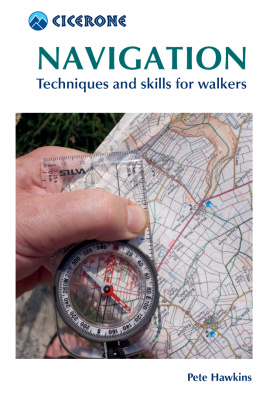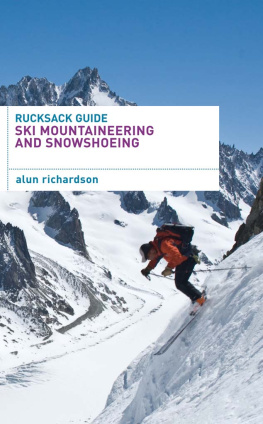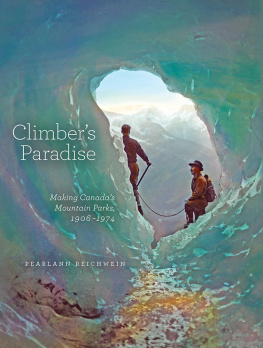
Mountain Walking and Trekking is the first book in the Rucksack Guide series and covers the skills required to become a competent mountain walker. For walkers, the real adventure starts when you step off the paths and explore the parts of the map where only streams, crags and contour lines exist. This handy book can be kept in your rucksack and will help you to gain the experience to walk safely anywhere in the world.
The Rucksack Guide series tells you what to do in a situation, but it does not always explain why. If you would like more information behind the decisions in these books, go to Mountaineering: The Essential Skills for Mountaineers and Climbers by Alun Richardson (A&C Black, 2008).
For more about the author, his photographs and the mountaineering courses he runs go to:
www.alunrichardson.co.uk
The secret to being safe in the mountains is to understand the environment and to be prepared for anything it can throw at you. Be independent and self-sufficient we do not have the right to be rescued.
Plan your route Examine the map carefully. If the weather is poor and the route complicated, put bearings and distances on the map for key stages.
Let friends know of your destination Leave a map or route card with friends or family with your intended route. Inform the same people of when you return.
Carry the correct equipment There is no such thing as bad weather, only inappropriate clothing.
RUCKSACK ESSENTIALS FOR DAY WALKING
Map stored in a watertight case
Compass (optional GPS receiver)
Extra clothing
Extra food and water
First aid kit
LED Head torch (extra bulb/batteries)
Knife (or multi-use tool)
Sunglasses
Sunscreen
Water bottle
Whistle
Emergency survival bag
Have you packed your rucksack with the necessary items ()?
Strong winds and poor visibility slow you down are you protected from the worst weather?
What route are you taking? In what general direction? Break your route down into smaller sections, creating a mental picture of the legs.
How far is the walk? How long will it take?
Can you shorten the walk if required?
How steep is the terrain?
What is the ground like will it speed you up or slow you down?
Are there any prominent features you will pass on the way e.g. streams, paths, buildings, valleys?
Are you going round hills or over them?
Are there any dangers (steep slopes, rivers, hidden cliffs)?
Trekking in the Alps
Dont walk too fast enjoy it
Start slowly and speed up.
Keep something in reserve in case you need it.
Walk for at least an hour before stopping for your first rest.
Straighten your rear leg in between every step so that it is supported by bone and not muscle.
Relax the muscles of the forward leg.
Tighten your laces.
Bend your knees and place each foot lightly.
Dont completely straighten your leg.
Use the thigh muscles to absorb the impact, and not the knees.
Keep a measured pace and zigzag to shift the strain.
Stand in the gaps between stones, rather than on top of them.
AVOIDING KNEE INJURIES |

|
Maintain the strength of the muscles supporting the knees, especially the quadricepts, which take some of the load off our joints. |
The massive choice of equipment available can make buying kit a nightmare. Borrow equipment at first, and when you do buy take your time; read the latest reviews from the experts.
Boots must be well constructed, water resistant, have an aggressive tread pattern, a medium level of ankle support and, most importantly, a good resistance of the sole to lateral twisting. Use good, well-fitting socks.
Type of boot | Pros | Cons |
Approach shoes/soft-fabric boots | Fine for treks on simple tracks Lighter and dry faster Cheaper | Dont handle well in rugged terrain or poor weather Ankle support and lateral stiffness are often lacking |
Leather boot | Still the most popular choice with mountain walkers Sturdy ankle support Can handle poor weather and grassy slopes | You require a good water proofing agent to care for them Can be expensive |
Gore-tex boots | Light Great in hot conditions | Terrible waterproofing in wet, muddy conditions |
Getting a good fit
Put the boot on un-laced. Push your foot forwards until your toes hit the front; you should then be able to squeeze a finger down the back of the heel.
Next, lace the boots properly by standing up to weight the foot, but not too tightly over the arch the foot is very sensitive to pressure.
A good fit is one where there is no pressure on your toes, you can wiggle them, there is no side-to-side movement of the foot and your heel does not lift.
If in doubt, buy larger.
Put both boots on and simulate uphill and downhill walking.
Wear a loaded rucksack because this will alter the shape of your foot.
Finally try male and female versions you never know!
Caring for boots
Stuff wet boots loosely with newspaper and leave them to dry in a warm, but not hot, place. Apply waterproofing to clean boots a few days before it is needed, to allow it to soak in (avoid too much treatment as it can soften the leather).
Socks
Socks should be snug with a smooth knit, good shape and elasticity, and made of wool or synthetic fibres to draw moisture away.
A thin liner and a thicker sock will reduce the chance of blisters.
A Gore-tex sock worn over a thin liner sock functions like a Gore-tex boot.
Do not roll your socks over the top of your boots or tuck your trousers into them as grit gets into the boot more easily.
Wash and moisturise feet every day.
Air feet regularly.
Use powders or antiperspirant to keep them dry, reducing blisters.
Cut nails by following the contour of the nail, so that the nail corner is visible.
BLISTERS
If your boots fit and they are laced correctly, you wear good socks and you look after your feet, you should never get blisters. If you feel a hot spot, act immediately. Always pop the blister, but do it neatly. Use a sterilised needle and pop several holes in the blister, press it flat and apply a small square of gauze to pad it. Hold the gauze in place with tape as it can be slippery. Plasters fall off, making a sticky mess at the first moment of perspiration.
Check how you walk by looking at the soles of an old pair of shoes:
Neutral The wear is centralised to the ball of the foot and a small portion of the heel.
Next page














